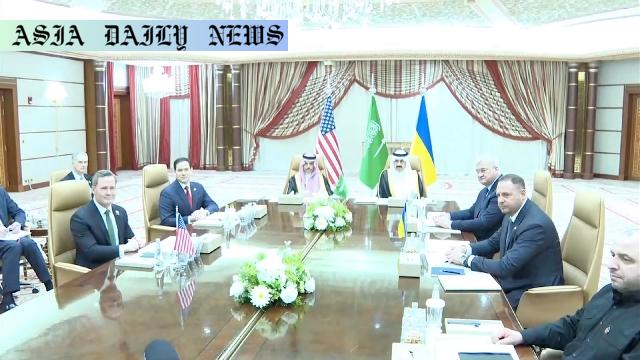Ceasefire talks between US and Ukraine may focus on ending hostilities with Russia, emphasizing truce in air and sea.

The Call for Ceasefire: US and Ukraine’s Initiative
The ongoing conflict between Ukraine and Russia, now a focal point of international discussions, may see a new development through discussions aimed at a partial ceasefire. Scheduled to take place in Saudi Arabia, these talks hold the potential to address the escalating humanitarian crisis and set the groundwork for future peace. The U.S. Secretary of State Marco Rubio echoed a cautiously optimistic stance towards Ukraine’s initiative. Ukrainian President Volodymyr Zelenskyy proposed this plan in early March, bringing new hope for tangible progress in halting the conflict.
The partial ceasefire plan doesn’t imply an immediate end to hostilities but focuses on targeted concessions that could alleviate civilian suffering. Among the key elements suggested by Zelenskyy are: the release of prisoners, implementation of a truce in the air and sea, and a mutual ban on missile, drone, and bomb attacks on infrastructure. These steps, albeit initial, have been recognized as significant by global leaders, including Rubio, although he highlighted that further negotiations would be necessary to achieve a sustainable resolution.
Key Proposals for Truce and Their Implications
One of the most critical aspects of Zelenskyy’s ceasefire proposal is a truce in the air and sea, a measure aimed at protecting civilian lives and critical infrastructure. The ongoing missile and drone attacks have devastated energy grids, hospitals, and other essential amenities, causing widespread suffering and displacement. A ban on such activities would mark a significant de-escalation and pave the way for trust-building between the involved parties.
Additionally, the release of prisoners as part of the initial steps is significant. For many families torn apart by the war, this measure would not only be a symbolic gesture but could also set the tone for subsequent negotiations focusing on humanitarian priorities. Rubio’s acknowledgment of this plan suggests that the U.S. sees merit and feasibility in adopting these measures as a foundation for eventual peace.
The Role of US Diplomacy: A Cautious but Open Approach
The involvement of the United States in these talks underscores the pivotal role it plays in international diplomacy. While the primary responsibility for the resolution rests with Ukraine and Russia, the U.S. offers significant political, military, and economic backing to Ukraine. Secretary Rubio’s statements reflect a pragmatic yet optimistic approach, signaling that the U.S. supports initial steps like a truce and shared agreements. However, Rubio has also acknowledged that these talks represent a mere beginning and that substantial efforts would be necessary in the months to come.
Furthermore, questions regarding the resumption of suspended intelligence sharing and arms supplies linger in the background. These measures—key to Ukraine’s resilience in the conflict—might hinge on the outcomes of the Saudi discussions. Rubio stated that further decisions about lifting the pauses on these supports would be contingent on the success of the upcoming negotiations.
Repercussions and Look Ahead
The proposed ceasefire frameworks, while promising, are fraught with challenges. Historical precedents have shown that partial truces can be precarious, often vulnerable to violations and renewed hostilities. The complexity of the Russia-Ukraine conflict, compounded by geopolitical interests, raises skepticism about the sustainability of such measures without broader commitments. However, Zelenskyy’s call for a ceasefire indicates Ukraine’s willingness to negotiate for peace while safeguarding its sovereignty and territorial integrity.
If successful, these talks could serve as a model for conflict resolution in other regions. They also spotlight the critical importance of international cooperation in addressing disputes involving major powers like Russia. The focus now rests on how willing Moscow will be to reciprocate and whether the framework gains global support, fostering accountability among all parties.
Commentary
The Promise of a Ceasefire: A Look at the Stakes
The proposal for a partial ceasefire between Ukraine and Russia marks a crucial moment in the ongoing conflict. As the war continues to inflict immense suffering on civilians and strain international relations, steps like these offer a tentative but significant step toward a much-needed resolution. The inclusion of measures such as truces in the air and sea and the release of prisoners speaks to the pressing need to prioritize humanity amidst the chaos.
However, one cannot ignore the inherent challenges such an initiative faces. Trust remains a fragile commodity in a war characterized by violations and recriminations. Russia’s commitment to abiding by these principles, should the talks succeed, will be scrutinized closely by the international community. It will require ongoing vigilance and transparency to ensure these measures are respected and upheld.
The U.S. Role in Paving the Way for Peace Potential
The United States’ active participation in these deliberations highlights its key position in the global order. Though not directly at war, the U.S.’s backing of Ukraine demonstrates how international alliances can influence outcomes in regional conflicts. Secretary Rubio’s cautious optimism for the proposed measures reflects a balanced approach, offering support while emphasizing the need to be realistic about next steps.
It’s also significant to consider the broader implications for U.S. policy. Supporting a ceasefire could position the U.S. as a mediator, paving the way for greater influence in post-conflict discussions. However, the administration must avoid appearing overly prescriptive, ensuring that Ukraine retains its agency as a sovereign state in negotiations.
A Potential Turning Point That Requires Unity
These discussions and potential outcomes, if successful, could herald a turning point in the Russia-Ukraine conflict. They also highlight the importance of global solidarity in ensuring peace efforts are honored. The international community must rally behind frameworks like these without compromising on issues of justice and accountability. Only through coordinated efforts can peace take root and endure.
As talks progress, cautious optimism mixed with steely pragmatism will be essential. While we all hope for peace, it is clear that the path forward will require patience, commitment, and deep international cooperation.


